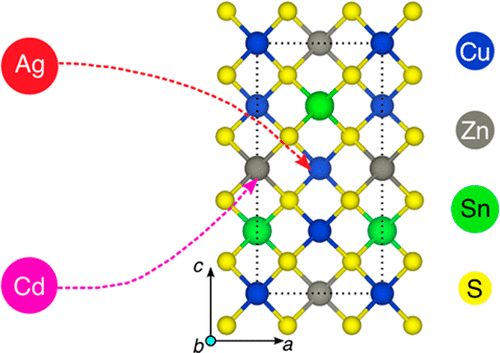当前位置:
X-MOL 学术
›
Chem. Mater.
›
论文详情
Our official English website, www.x-mol.net, welcomes your feedback! (Note: you will need to create a separate account there.)
Understanding the Effects of Cd and Ag Doping in Cu2ZnSnS4 Solar Cells
Chemistry of Materials ( IF 8.6 ) Pub Date : 2018-06-18 00:00:00 , DOI: 10.1021/acs.chemmater.8b00677 Gopalakrishnan Sai Gautam , Thomas P. Senftle , Emily A. Carter
Chemistry of Materials ( IF 8.6 ) Pub Date : 2018-06-18 00:00:00 , DOI: 10.1021/acs.chemmater.8b00677 Gopalakrishnan Sai Gautam , Thomas P. Senftle , Emily A. Carter

|
Cu2ZnSnS4-based solar cells, which constitute an inexpensive, beyond-Si photovoltaic technology, often suffer from low open-circuit voltage and efficiency. This drawback is often attributed to disorder in the Cu–Zn sublattice of the kesterite structure. While previous experiments have reported improved performances with isovalent substitution of Cd and Ag for Cu and Zn, respectively, the fundamental driving force for such improvements remains unclear. Here, we use density functional theory to study bulk stability, defect, and surface energetics, as well as the electronic structure of these dopants in Cu2ZnSnS4. We find that Cd and Ag can increase efficiencies, depending on the dopant concentration and Cu content used during synthesis. Most importantly, we find that a low level of Cd doping can suppress disorder in the kesterite phase across all Cu concentrations, while a low level of Ag doping can do so only when Zn- and Sn-rich conditions are employed. A higher Ag content is beneficial as it stabilizes the kesterite structure, whereas a higher Cd content is detrimental as it stabilizes the lower-gap stannite structure. Cd does not significantly influence the surface energetics of kesterite Cu2ZnSnS4. Ag, on the other hand, decreases the surface energies significantly, which would favor smaller particle sizes. We thus attribute the coarsening of particle size and changes in morphology observed during Cu2ZnSnS4 synthesis to annealing conditions during sulfurization and selenization, instead of any effect of Cd or Ag. Finally, we suggest the exploration of abundant, nontoxic, isovalent dopants, i.e., different from the attributes of Cd and Ag, to improve the performance of Cu2ZnSnS4.
中文翻译:

了解Cd和Ag掺杂对Cu 2 ZnSnS 4太阳能电池的影响
构成便宜的,超越硅的光伏技术的基于Cu 2 ZnSnS 4的太阳能电池经常遭受低开路电压和效率的困扰。这种缺陷通常归因于钾盐沸石结构的Cu-Zn亚晶格中的无序。尽管先前的实验已经报道了用Cd和Ag分别取代Cu和Zn可以改善性能,但是这种改进的基本驱动力仍然不清楚。在这里,我们使用密度泛函理论研究Cu 2 ZnSnS 4中这些掺杂剂的体稳定性,缺陷和表面能,以及这些电子的电子结构。。我们发现Cd和Ag可以提高效率,这取决于合成过程中所用的掺杂剂浓度和Cu含量。最重要的是,我们发现,低水平的Cd掺杂可以抑制在所有Cu浓度范围内的Kesterite相中的无序,而低水平的Ag掺杂仅在采用富含Zn和Sn的条件下才能做到。较高的Ag含量是有益的,因为它稳定了kesterite结构,而较高的Cd含量对稳定了较低空隙的锡矿结构是有害的。Cd不会显着影响Kesterite Cu 2 ZnSnS 4的表面能。另一方面,Ag会显着降低表面能,这将有利于较小的颗粒尺寸。因此,我们将粒度的粗化和在Cu 2 ZnSnS 4合成过程中观察到的形态变化归因于硫化和硒化过程中的退火条件,而不是Cd或Ag的任何作用。最后,我们建议探索丰富的,无毒的,等价的掺杂剂,即不同于Cd和Ag的属性,以改善Cu 2 ZnSnS 4的性能。
更新日期:2018-06-18
中文翻译:

了解Cd和Ag掺杂对Cu 2 ZnSnS 4太阳能电池的影响
构成便宜的,超越硅的光伏技术的基于Cu 2 ZnSnS 4的太阳能电池经常遭受低开路电压和效率的困扰。这种缺陷通常归因于钾盐沸石结构的Cu-Zn亚晶格中的无序。尽管先前的实验已经报道了用Cd和Ag分别取代Cu和Zn可以改善性能,但是这种改进的基本驱动力仍然不清楚。在这里,我们使用密度泛函理论研究Cu 2 ZnSnS 4中这些掺杂剂的体稳定性,缺陷和表面能,以及这些电子的电子结构。。我们发现Cd和Ag可以提高效率,这取决于合成过程中所用的掺杂剂浓度和Cu含量。最重要的是,我们发现,低水平的Cd掺杂可以抑制在所有Cu浓度范围内的Kesterite相中的无序,而低水平的Ag掺杂仅在采用富含Zn和Sn的条件下才能做到。较高的Ag含量是有益的,因为它稳定了kesterite结构,而较高的Cd含量对稳定了较低空隙的锡矿结构是有害的。Cd不会显着影响Kesterite Cu 2 ZnSnS 4的表面能。另一方面,Ag会显着降低表面能,这将有利于较小的颗粒尺寸。因此,我们将粒度的粗化和在Cu 2 ZnSnS 4合成过程中观察到的形态变化归因于硫化和硒化过程中的退火条件,而不是Cd或Ag的任何作用。最后,我们建议探索丰富的,无毒的,等价的掺杂剂,即不同于Cd和Ag的属性,以改善Cu 2 ZnSnS 4的性能。



























 京公网安备 11010802027423号
京公网安备 11010802027423号